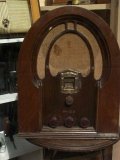Semiotics
Here are some of my objections to semiotics as a master-narrative theory model for core radio theory:
| Successful as it was in the past, it is no longer a master-narrative theory for radio. |
| Some terms from semiotics are still useful, but need careful critiquing. (Master Narrative theorising (the flight from) - see Radio theory - what is it for? What is it?) |
Beck, Alan, 2000, 'Playing by ear: new ways of teaching and researching radio drama', Studies in Theatre and Performance Journal
|
For me, this is also a way of leaving 'scientific' semiotics behind and I do not myself see a further application of the semiotic model in radio drama, beyond a simple taxonomy and useful in itself for that. I cannot go beyond Crisell's Chapter 3 'Radio signs and codes' (Crisell, 1994, p. 42-63). Scannell (1991) p. 10-11 has effectively rejected the analytical value of structuralist semiotics in broadcast media (the encoding-decoding model and its language base). Other indictments have been: semiotics' unequal and inverted binary system, its divorce from perception and reception, and, from what work has been published, its lengthy and obvious 'combinatoire' of various instances and applications (for me, some published semiotic research in theatre, music and dance). Shingler & Wieringa (1998) sensibly make no use of semiotics except briefly for 'codes' (categories of speech, music, etc.). Not every radio element or signifier or perceptible, never mind the search for the atomic sign, fits neatly into a code or a subcode, and even less so for a high production genre such as the radio play, and its synergy of elements. References here Scannell, Paddy, ed., 1991, Broadcast Talk, London: Sage Crisell, Andrew, 2nd ed., 1994, Understanding Radio. New York and London: Routledge Beck, Alan, 2002, The Death of Radio? An Essay in Radio Philosophy for the Digital Age. Online book. Published by Sound Journal at http://www.savoyhill.co.uk/deathofradio/ As to structuralist semiotics, Scannell in Scannell, 1991, 10-11 has effectively rejected its analytical value in the broadcast media (semiotics' encoding-decoding model and its language base). General indictments against semiotic research results have ranged from wannabe imperialism (semioticians have applied it to everything), to its left-wing 'French connection', its alleged charlatanism, its inverted and unequal dualities (binary system), and that 'it tells us things we already know in a language we will never understand'. Note to 1.10.1 Also that the whole idea of the atomic sign a mistake and that this is divorced from perception and reception; and that semiotic results are an unnecessary, lengthy and obvious 'combinatoire' of various instances and applications. 1.10.1b My discussion is below in 6.4 and I am of the 'post hoc contra hoc' tendency, that is, looking back unfavourably on three decades of semiotic research. I teach semiotics only as a fossil of the 1970s, as a shaky system in itself of the sign function though related to valuable insights of structuralism, including that each perceptible has an ideologically determined basis. I cannot see an application for semiotics in radio unless as a simple taxonomy system, and useful in itself for that, but one which is not able to engage profoundly with the demands of any broadcast medium. I find the 'combinatoire', the listing of categories and subcategories, and signs, and what differs from other members in their species, unrewarding. However, semiotics does prompt an awareness of some foundational problems in radiowriting, such as what dependent on the language model, and so is a semantics of radio function (making sense of radio talk) and realized in verbal language, and what are the rivalling models - the extra-semantic and pragmatic concerns. 1.10.1c I am not aware of large-scale semiotic work on radio or of a radio-semiotic school beyond Scott, no date, electronic publication. Semiotics is mostly superseded by communications studies models. Shingler and Wieringa, 1998 for example sensibly make no use of semiotics except for 'codes', that is, categories of speech, music, noise, silence, etc., which I term domains. Scott however, in a work in progress on the classification of 'sonic types' and a 'semiotics of audibility' gives a systematic, if short, terminology (in Section 1) including: 'emitter' (the origin of the sound source), 'emission' ('what is given off' or 'the articulation of sound waves') and the 'listening subject'. He also admits that he oversteps the boundaries of semiosis in studying the referent. 1.10.2 On the other hand, the enigmas towards which semioticians point are of the first order of theorizing, but I prefer to assign these more particularly. As regards representation, (semiotics' iconic, symbol and indexical signs, etc.) I subsume this under piecemeal theorizing, e.g. radio's impression of reality effects and discourse analysis - especially as radio is predominantly vocalising. I do not believe that semiotic research work on a taxonomy for radio would yield valuable outcomes. When I look at lengthy semiotic analyses, on theatre, dance and music for example, I find the taxonomy exhausting and the operative method contradictory of itself. One model is succeeded by another, which is followed by another, and the first-in-line model then drops out of the frame of analysis, and so on. Further, for me, not every radio element or signifier or perceptible fits neatly into a code or subcode, nor do I consider 'codes' to be in themselves empty, before an 'etic' (a perceptible sound) becomes an 'emic' (culturally determined). Fuzzy logic, in my belief, should guide system-building; and no radio system could ever be complete, suggesting the research horror of an endlessly receding closure. However, I do find the principle of a gestalt, some sort of syntactic field, a necessity. Note to 1.10.1
Note to 5.9 The semiotic model has been heavily critiqued in relation to other media. Allen and Smith in their discussion of 'What is Cinematic Representation' refer to: ... an uncritical and idiosyncratic use of semiotics-loosely allied with anti-illusionist, modernist aesthetic practice-was wielded as a weapon to combat the purported illusionism of the image. (Allen and Smith, 1997, 39) The following quotation sums up the objections specific to radio: To think of programmes as texts and audiences as readers is
to mistake the communicative character of much of the output
of radio and television. In particular it fails to recognize
the liveness of radio and television, their embeddedness in the
here and now (their particularity) and the cardinal importance
of context and audiences. One can point out that radio's signs are motivated and cannot be deftly separated one from another. To place radio's signifiers within code systems (Crisell, 1994, 43) depends on a sometimes impossible sorting system (knowing what the codes are in the first place, why that code and not another?, why any code?). As for structures, these can depend on certain constricting and long-standing radio traditions (genre, the magazine programme, music). Not all material things are translated into signs. It could be argued that the 'thinginess' of the material world (Duns Scotus' 'haeccitas') may be resistant to language and signification, and may be independent of these. (That is central to the enterprise of Samuel Beckett's nihilisation of language and radio's features in his radio plays, and some of postmodernist performance dance, to give a current postmodernist example.) Nor are signs immediately available to consciousness for selection and insertion into the system of signification, and for decoding. The famous binary-oppositions system of semiotics can conceal other hierarchies. Yet the very reason for semiotics' efficacy (in its classic period of the 1970s) is the promise of a 'science', objective categorisations and an all-embracing hold on culture (Metz, 1974, 56ff.). Semiotics also focused on decontextualized and isolated texts. References here Allen, Richard and Smith, Murray, 1997, Film Theory and Philosophy, Oxford: Oxford University Press. Tarnay, Laszlo, 1997, 'The Rear Window of Essentialism', Film-Philosophy,
vol. 1 no. 6, September 1997, at http://www.film-philosophy.com/vol1-1997/n6tarnay.html Metz, Christian, 1974, Language and Cinema, trans. Umiker-Seboek, Donna Jean, The Hague: Mouton. Scannell, Paddy, ed., 1991, Broadcast Talk, London: Sage Crisell, Andrew, 2nd ed., 1994, Understanding Radio. New York and London: Routledge.
SEMIOTICS GUIDE
|
| To Theory - what is it? |
| To Radio theory - what is it for? What is it? |
|
|




